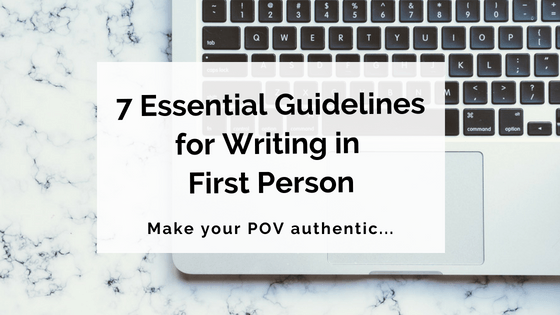One of the first things you need to decide when setting out to write a story is what point of view it will be told from. This not only means deciding on the main character (or characters) you’ll be following, but also whether you’re telling their story from first or third person perspective.

(A note on second person perspective: it does exist, and you can use it. However, it’s very difficult to use effectively and to sustain throughout a longform story, so most people avoid it when writing novels. First and third person are far, far more common.)
First-person narration, of course, refers to stories told by the character themselves, using ‘I’ or ‘we’. Third-person narration is someone else telling the character’s story, using ‘he/she/they’.
If you’re thinking about writing in first person, there are a few guidelines you should be aware of to ensure your story is told in the most effective way possible.
Let’s jump in!
1. Decide if first person is right for your story
Before you start writing, consider carefully whether first-person narration is the best style of narration for the story you want to tell.
First-person narration is a great tool for many reasons. It provides a sense of intimacy between reader and character; the character is essentially telling the reader their story directly, and the reader is privy to that character’s every thought, action, emotion and experience.
First-person perspective allows you to get into a character’s head a little more than other points of view – even close third-person perspective.
Third-person narration always naturally encompasses some measure of distance between reader and character. So if a super-close experience is what you’re looking for, you can’t really beat telling a character’s story from their direct point of view.

However, there are some reasons you might choose to step away from first person instead.
If you’re planning on writing from multiple points of view, for example, using first-person narration for all your POVs might make things a little trickier than they need to be.
Your book’s target audience should also be considered. For whatever reason, younger readers and readers of genre fiction tend to be more accepting of first-person narration than, say, older readers who prefer literary fiction.
Think about who you’re writing for, and which method of storytelling might allow you to best connect with them.
2. Pick a tense and stick with it
Once you’ve decided on writing in first person, it’s time to pick a tense to pair with it!
You’ll generally be choosing between present and past tense. Like second-person narration, future tense is an option, but few writers take it – it’s difficult to get right.
The first person, present tense combination has proven effective for many authors, and is particularly common in the world of young adult fiction. This combination lends a sense of immediacy and urgency to the story, so it’s well-suited to fast-paced stories with high stakes and lots of action.

Combining first person and past tense is just as common. It allows for a more traditional ‘storytelling’ feel, as the narrator is recounting events that have happened in the past from their own perspective.
Whichever tense you choose, it’s important to stick with it. Once you get into the flow of writing, you’ll probably have no trouble with this, but we’ve found there’s something about first-person narration that makes it a touch trickier to stick to your tense!
If in doubt, send your work over to a critique partner or beta reader, who’ll be able to help you identify areas you’ve missed where your tense has slipped.
3. Develop a strong voice
Voice is important in any type of storytelling, but none more so than first-person narrative.
When writing in first person, it’s not just your authorial voice coming out on the page; it’s literally your character’s voice. Your character is speaking directly to readers to tell their own story. This means they need to have their own distinct voice.
No reader will enjoy a first-person narrative that’s essentially a bland, straightforward telling of events. To help readers connect with your character, you need to inject some of their personality and essence into the way you tell their first-person story.
You can develop your character’s voice in a number of ways: through language, emotion, worldview… Delve into who they are as a person, and try to let that sing through in the first-person narrative.

Adding further to this advice: always distance yourself somewhat from your character. This can, of course, be more difficult in first person, where you’re literally using the word ‘I’ and putting yourself directly into the character’s headspace.
But readers are all too quick to notice when a character’s voice and a writer’s blend together and become indistinguishable from one another. And take it from us: they won’t appreciate it.
First-person narration shouldn’t be solely used as a tool to get your own thoughts and feelings out onto the page. (That’s what blogs, diaries and morning pages are for!)
Characters shouldn’t be mouthpieces for the author. They should be fully developed in their own right, with their own unique and strong voice – especially if that voice is being used to tell the story in first person.
4. Avoid too much introspection
While first-person narration is a great tool to help get inside a character’s head, you don’t want to spend all your time there. Readers don’t, either.
Beware of extended periods of inner monologue or introspection from your POV character. Yes, readers want to know what the character is thinking and how they’re feeling – but if that’s all they get, the story is going to fall flat.
Plot, action and dialogue are as vitally important in first-person narrative as they are in any other style. Your POV character needs to be doing things, interacting with other characters and noticing the world around them, not just ruminating on their own thoughts and feelings.

Remember, too, that not every story told in first person has to revolve centrally around the narrator. You can also use first person to direct attention more clearly onto another character. F. Scott Fitzgerald’s The Great Gatsby is a perfect example of this.
From the title, you might expect that the story will be told from the perspective of Jay Gatsby himself – but it’s not. It’s told in first person from Nick Carraway’s perspective, which allows readers to view the title character in an entirely different light than they would have had the story been told from the perspective of Gatsby himself.
5. Vary your phrasing
When writing in first person, it can be all to easy to fall into the trap of repetitive words, phrasing and sentence structures. It’s likely that in your first draft, the word ‘I’ will pop up a lot more than is desirable!
Repetition of phrasing like ‘I did this’ and ‘I did that’ can really start to jar with a reader after a while, especially if the word ‘I’ is used to start almost every sentence.
Keep an eye on your phrasing and make sure it isn’t becoming too repetitive. It helps to get into the habit of changing up your sentence structure while writing, but it can always be improved in the editing phase as well.

One handy hint is to avoid unnecessary phrases like ‘I saw’, ‘I heard’ etc. wherever possible. For example, instead of ‘I heard an eerie howling echoing through the woods’, simplify it to ‘An eerie howling echoed through the woods’.
Readers should feel as if they’re in the narrator’s head, not watching them from outside as they would in a third-person narrative. In first person, readers don’t need to be told explicitly when the character is seeing, hearing or feeling something; they need to experience it with them directly.
Keeping this in mind should help you out when it comes to reducing use of ‘I’.
6. Practise showing, not telling
The ‘show, don’t tell’ mantra is a common one for fiction writers. But never is it more important than in first-person narration.
Unfortunately, it’s easier to fall into the ‘telling’ trap when writing in first person. But there are a few tips you can keep in mind to help you avoid it.
Firstly, remember that the narrative does not need to describe every single thing a character does, even when it’s told in first person. Instead of ‘I walked over to the dresser, picked up a brush and ran it through my hair’, for example, keep things simple with ‘I ran a brush through my hair’.

Speaking of hair – that reminds us of another common trap fallen into by authors writing in first person… Painting a picture of your first-person narrator by having them look in a mirror and describe themselves! (How many times have you looked at yourself in the mirror and catalogued your physical features in your head, one by one?!)
Tactics like these come across as forced and unnatural, and really detract from the first-person narrative. They’re essentially the first-person perspective version of ‘telling’ the reader something directly, rather than letting it flow naturally through the narrative.
One more thing to remember: you don’t need to italicise and tag your character’s thoughts as you do in third-person narration. The entirety of first-person narration, after all, is your character’s thoughts. Simply allow them to weave naturally throughout the narrative alongside action and dialogue.
7. Remember the limits of first-person perspective
Something to keep in mind when choosing first-person narration is the limited perspective it offers for storytelling.
By writing in first person, you’re committing to telling the story solely through that character and what they know, think, feel and experience.

Your narrator must be in each and every scene, and you can’t include details they don’t know. Every event in the story is displayed through that narrator’s eyes and coloured solely by their interpretation.
However, these limitations don’t necessarily need to be negative. When done right, first-person narration can be an extremely effective, intimate and in-depth mode of storytelling, which allows you (and your readers) to get right to the heart of a character.
***
What’s your favourite POV to read or write in? What sorts of stories do you think make for the best first-person storytelling?
Let us know in the comments!
One response to “7 Essential Guidelines for Writing in First Person”
Thanks for the tips Claire!